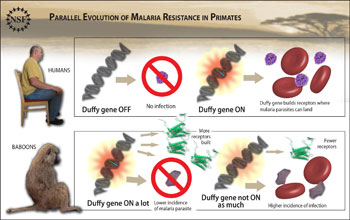Multimedia Gallery
Evolution of Malaria Resistance in Primates
Humans and baboons share similar evolutionary histories and environments in the East African savanna. Parallel evolution has also been demonstrated in how variation of the Duffy gene affects their respective resistance or susceptibility to infection by malaria parasites. The mechanism is well-known in humans: when the Duffy gene is "on," it builds receptors on the surface of red blood cells, allowing malaria parasites to land; when the gene is "off," there is no infection.
This image accompanied NSF press release, "Variation in the Same Gene Affects Rate of Parasite Infection in Both Humans and Baboons."
Credit: Zina Deretsky, National Science Foundation
Images and other media in the National Science Foundation Multimedia Gallery are available for use in print and electronic material by NSF employees, members of the media, university staff, teachers and the general public. All media in the gallery are intended for personal, educational and nonprofit/non-commercial use only.
Images credited to the National Science Foundation, a federal agency, are in the public domain. The images were created by employees of the United States Government as part of their official duties or prepared by contractors as "works for hire" for NSF. You may freely use NSF-credited images and, at your discretion, credit NSF with a "Courtesy: National Science Foundation" notation.
Additional information about general usage can be found in Conditions.
Also Available:
Download the high-resolution JPG version of the image. (469 KB)
Use your mouse to right-click (Mac users may need to Ctrl-click) the link above and choose the option that will save the file or target to your computer.

